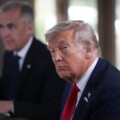In the midst of the highest consumer price inflation rates seen in decades, many economists are pointing to the “easy money” policies the Bank of Canada and other central banks adopted in early 2020 when the COVID panic hit.
Although it makes sense to blame rising prices on a flood of new dollars (and euros, etc.), this explanation also raises a new puzzle. Why are Canadians paying an average of more than two dollars per litre for gasoline now, but not back in 2010? After all, the Bank of Canada and the Federal Reserve engaged in—at the time—unprecedented monetary injections in the wake of the 2008 financial crisis. If “loose money” is the culprit today, why didn’t consumer prices explode then just as now?
Part of the answer is that the public was panicked after 2008 and its demand to hoard money skyrocketed. That’s why massive infusions of cash from central banks didn’t have the same impact back then as they did after the 2020 COVID crisis. We can see this distinction clearly in the data if we look at broader measures of money.
For example, consider the United States. The Federal Reserve’s total asset holdings jumped from $925 billion in mid-September 2008—when the financial crisis struck and Lehman Brothers failed—to a whopping $2.2 trillion over the next two months. When a central bank buys new assets (in this case, U.S. treasuries and mortgage-backed securities), the process creates new dollar reserves for the banking system. Thus, the most narrow measure of the U.S. money supply, namely the “monetary base” (sometimes called M0), roughly doubled in the 12 months following the September 2008 crisis.
Indeed, back in 2008 we also saw a large spike in the next measure of money, M1, which counts paper currency and the public’s checking account balances (there was a definition change in the way U.S. authorities measure M1 starting in 2020, but that doesn’t affect our analysis of the 2008 episode). Specifically, in the U.S. M1 increased more than 20 percent over the course of 2008 whereas this measure of the U.S. money supply had been pretty flat throughout 2006 and 2007. Again, just looking at these numbers, one might have supposed that U.S. consumer prices would rise sharply in 2009. But they didn’t.
But when we move to the next level we begin to see a difference between then and now. The measure M2 includes not just paper cash and chequing account balances, but less liquid claims such as deposits in retail money market funds. And following the 2008 crisis, U.S. deposits in these funds collapsed by some 20 percent (about $200 billion) over the course of 2009. In terms of the broader measure of money, because this key constituent of retail money market funds was collapsing while other components (currency and checking accounts) were rising, the overall measure of M2 didn’t grow at an unusually high rate.
Specifically, in the 12 months following the financial crisis of the fall of 2008, M2 in the U.S. only grew 7 percent. In contrast, in the 12 months following the COVID panic in the spring of 2020, M2 in the U.S. grew 24 percent. This helps explain why consumer price index (or CPI) inflation has been so severe in recent years, while it was tame following the 2008 crisis.
The lesson for Canadian officials and the public should be clear. Other things equal, “easy money” policies cause consumer prices to rise, just as they teach in economics textbooks. The reason some economists (including this writer) gave premature warnings about inflation back in 2009 is that this natural tendency was more than offset by the public’s rushing out of less liquid forms of wealth (such as money market funds) and into safer forms such as commercial bank deposits. But the Bank of Canada must know that its “easy” policies after the 2020 pandemic help explain the current pain at the pumps.
Recommended for You

The Notebook by Theo Argitis: Carney’s One Big Beautiful Tax Cut, and fresh budget lessons from the U.K.

Rudyard Griffiths and Sean Speer: The fiscal hangover from the One Big Beautiful Bill hits Canada

Lucy Hargreaves: Canada needs builders, not bystanders

Need to Know: Mark Carney’s digital services tax disaster



